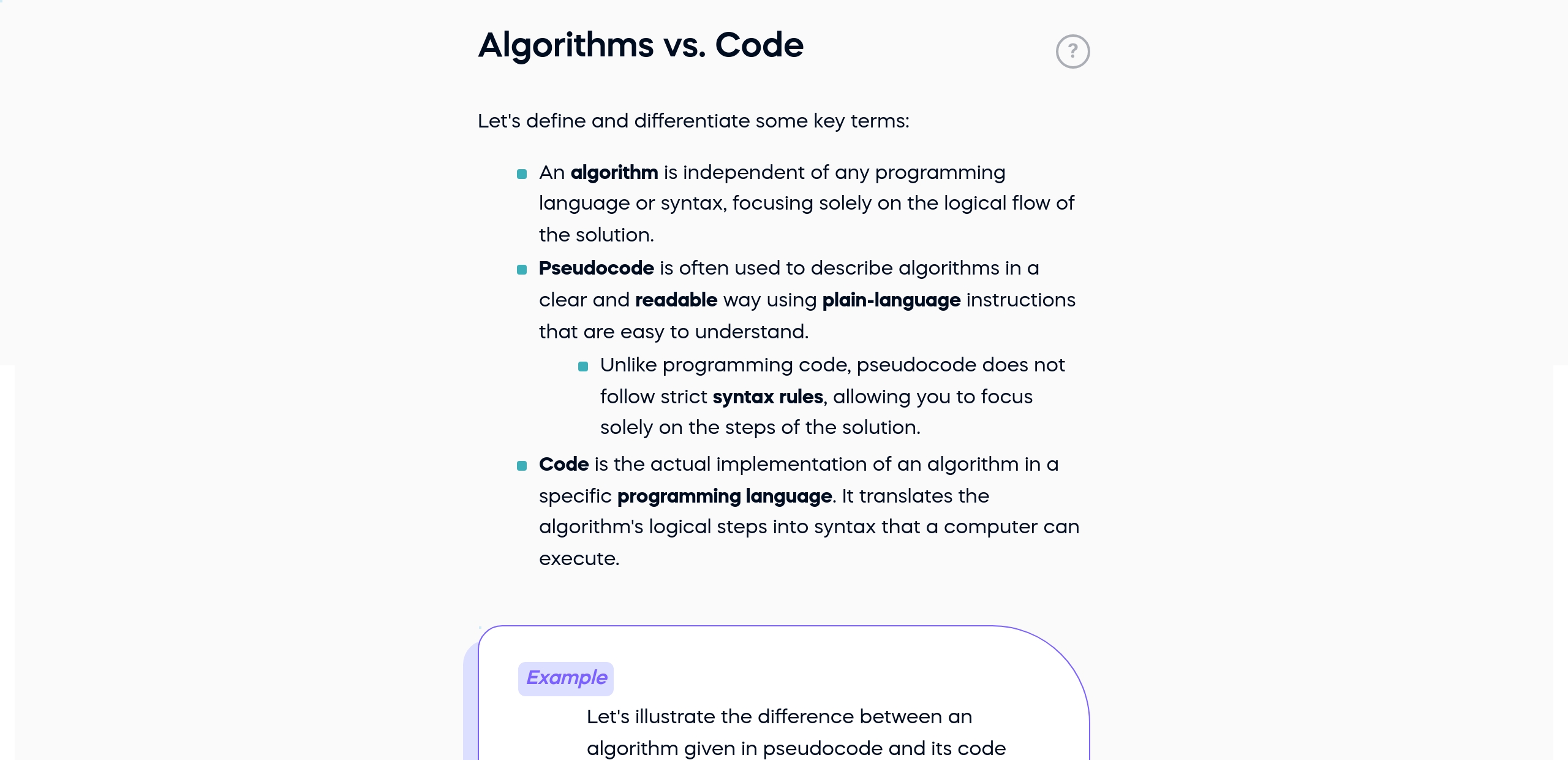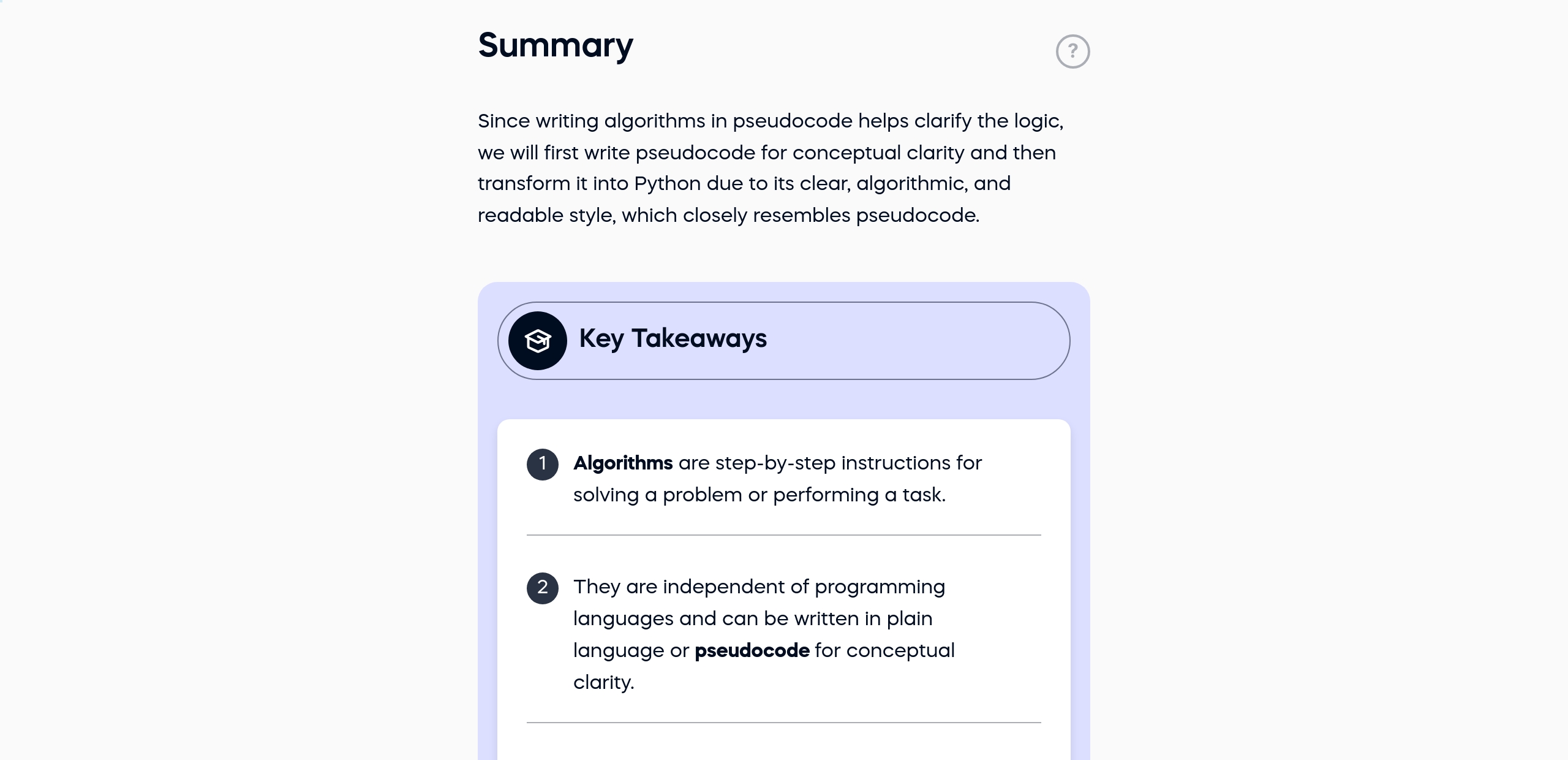Introducing Algorithms in Python
Explore essential algorithms in Python! Learn searching (Linear & Binary), sorting (Bubble, Insertion, Merge, Quick), and complexity analysis (Big O notation). Understand efficiency, recognize trade-offs, and build a strong foundation for developing optimized algorithms in data science, software development, and coding interviews.
 Start for Free
Start for Free
What you get:
- 2 hours of content
- 17 Interactive exercises
- 8 Coding exercises
- World-class instructor
- Closed captions
- Q&A support
- Future course updates
- Course exam
- Certificate of achievement
Introducing Algorithms in Python
 Start for Free
Start for Free
What you get:
- 2 hours of content
- 17 Interactive exercises
- 8 Coding exercises
- World-class instructor
- Closed captions
- Q&A support
- Future course updates
- Course exam
- Certificate of achievement
$99.00
Lifetime access
 Start for Free
Start for Free
What you get:
- 2 hours of content
- 17 Interactive exercises
- 8 Coding exercises
- World-class instructor
- Closed captions
- Q&A support
- Future course updates
- Course exam
- Certificate of achievement
What You Learn
- Understand algorithms and pseudocode, including their purpose, structure, and representation.
- Master Linear and Binary Search, recognizing when each is most efficient.
- Analyze algorithm complexity using Big-O notation to compare performance.
- Implement Bubble, Insertion, Merge, and Quick Sort while understanding their trade-offs.
- Identify the right algorithm for a problem based on efficiency and application.
- Build a strong foundation for problem-solving, relevant to programming and data-driven tasks.
Top Choice of Leading Companies Worldwide
Industry leaders and professionals globally rely on this top-rated course to enhance their skills.
Course Description
Programming has two essential parts: devising logic (algorithms) to solve problems using relevant data (data structures). In data science, efficient algorithms and appropriate data structures are crucial for effectively processing and analyzing large datasets. This Introducing Algorithms in Python course bridges these fundamental concepts of algorithms.
In this Algorithms in Python course, you'll start by immersing yourself in the world of algorithms. You’ll learn how to think critically and develop efficient solutions through essential searching techniques like linear search and binary search, as well as fundamental Python sorting algorithms—including bubble sort, insertion sort, merge sort, and quick sort. Implementing these algorithms in Python will enhance your coding proficiency and problem-solving skills, which are vital in data science.
By the end of our Introducing Algorithms in Python course, you'll have a solid foundation to tackle data science projects more effectively—equipped with the skills to write efficient code to handle varying data proficiently.
Are you an aspiring data scientist, programmer, or someone looking to strengthen your fundamentals? This Algorithms in Python course provides the knowledge to advance your skills and confidence in recognizing and developing efficient solutions and applications.
Start mastering essential algorithms in this Introducing Algorithms in Python Course today!
Learn for Free

1.1 Welcome to the Course
3 min

1.2 What Are Algorithms?
2 min

1.4 Algorithms vs. Code
1 min

1.6 Summary
1 min
Curriculum
- 2. Search Algorithms8 Lessons 17 Min
- Master Linear and Binary Search, understanding their strengths and limitations.
- Gain an intuitive grasp of efficiency—how different search strategies perform as data grows.
- Learn to choose the best search approach for different types of datasets and applications.
Introduction Read now1 minLinear Search Read now2 minLinear Search Implementation Read now2 minAnalyzing Linear Search Read now4 minSorted Data and Binary Search Read now3 minBinary Search Implementation Read now2 minAnalyzing Binary Search Read now2 minSummary: Search Algorithms Read now1 min - 3. Analyzing Algorithm Complexity5 Lessons 15 Min
- Understand how input size affects performance and why some algorithms scale better than others.
- Explore the growth of functions and how they influence execution time.
- Learn Big-O notation intuitively, using real-world analogies and comparisons.
Introduction to analyzing algorithm complexity Read now4 minFormalizing Big O Notation Read now2 minBest, Average, and Worst Case Read now3 minFundamental Complexity Classes Read now5 minSummary - Analyzing algorithm complexity Read now1 min - 4. Sorting Algorithms - I5 Lessons 27 Min
- Discover why sorting is fundamental for organizing, retrieving, and optimizing data.
- Learn how Bubble Sort and Insertion Sort work step by step.
- Compare their efficiency and understand where they are practical despite being slow.
Introduction - Sorting Algorithms - I Read now4 minNaive Sorting: Bubble Sort Read now13 minVisualizing Complexity Growth: From Constant to Quadratic Read now2 minNaive Sorting: Insertion Sort Read now7 minSummary - Sorting Algorithms - I Read now1 min - 5. Sorting Algorithms - II7 Lessons 38 Min
- Explore recursion as an alternative to iteration, forming the foundation for efficient sorting.
- Master Merge Sort and Quick Sort, understanding their divide-and-conquer strategies.
- Learn when to use Merge Sort for stability and Quick Sort for speed and in-place efficiency.
Introduction - Sorting algorithms - II Read now6 minMerge Sort Read now8 minComplexity of Merge Sort Read now4 minQuick Sort Read now10 minComplexity of Quick Sort Read now7 minSummary - Sorting algorithms - II Read now1 minYou Did It!2 min
Topics
Course Requirements
- Basic Python knowledge
- No prior experience needed in algorithms or data structures
- Willingness to learn and engage
Who Should Take This Course?
Level of difficulty: Beginner
- Early-stage programmers looking to build a solid foundation in algorithms.
- Students and self-learners who want to master searching, sorting, and complexity analysis.
- Aspiring data scientists and engineers seeking essential algorithmic skills.
- Developers looking to improve problem-solving abilities for coding interviews and real-world applications.
- Anyone curious about how algorithms work and how to apply them effectively.
Exams and Certification
A 365 Data Science Course Certificate is an excellent addition to your LinkedIn profile—demonstrating your expertise and willingness to go the extra mile to accomplish your goals.

Meet Your Instructor

I hold a PhD in Computer Science and have spent over 16 years in academia, teaching courses in Algorithms, Programming, Machine Learning, and Systems while mentoring students in research and applied problem-solving. My research includes QoS optimization in IoT, securing funding for experiments through FED4FIRE+ (An EU H2020 Project), and exploring AI-driven network efficiency. I have also worked as a Mentor at Udacity, guiding global learners in AI and Data Science. Through my teaching and mentoring, I tend to ensure that students develop both theoretical depth and practical problem-solving skills. I am committed to bridging theory and practice, making data-driven decision-making accessible, and equipping learners with the skills to excel in AI, software engineering, and beyond.
What Our Learners Say
365 Data Science Is Featured at
Our top-rated courses are trusted by business worldwide.